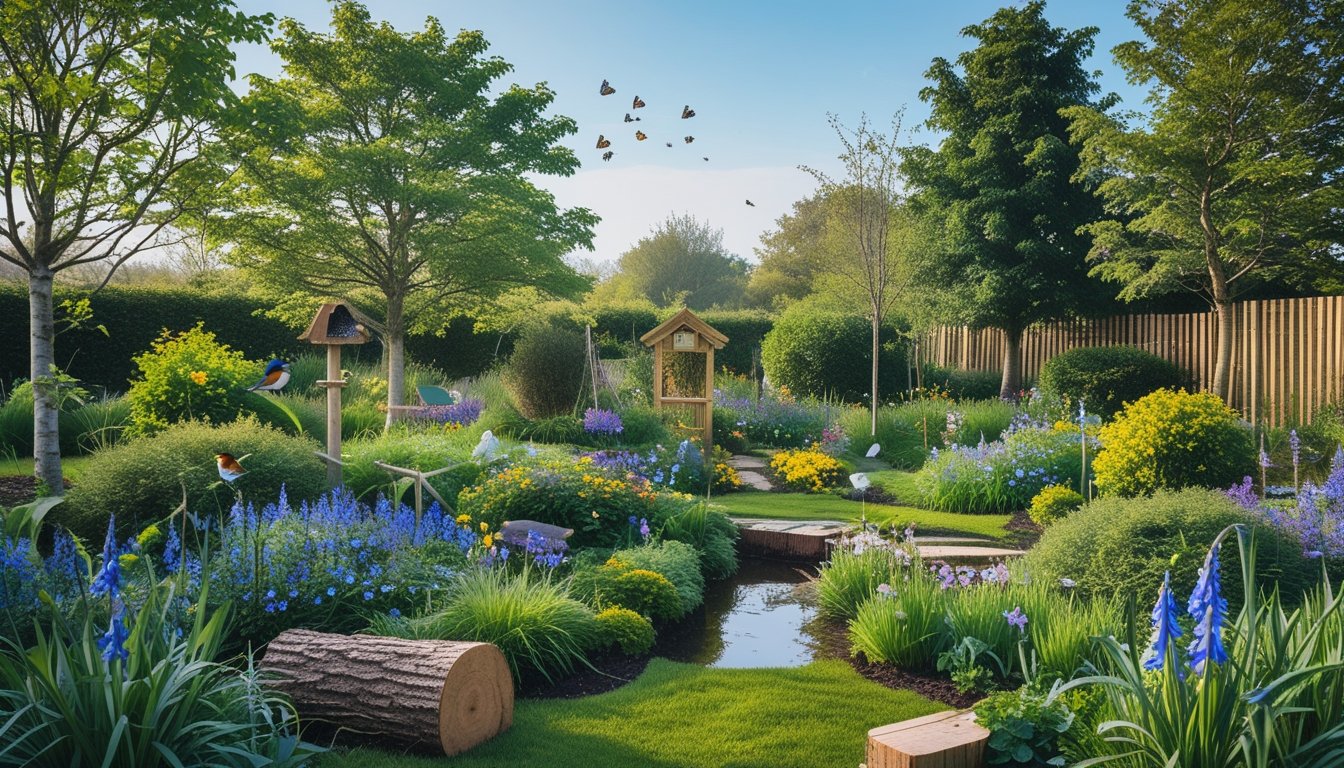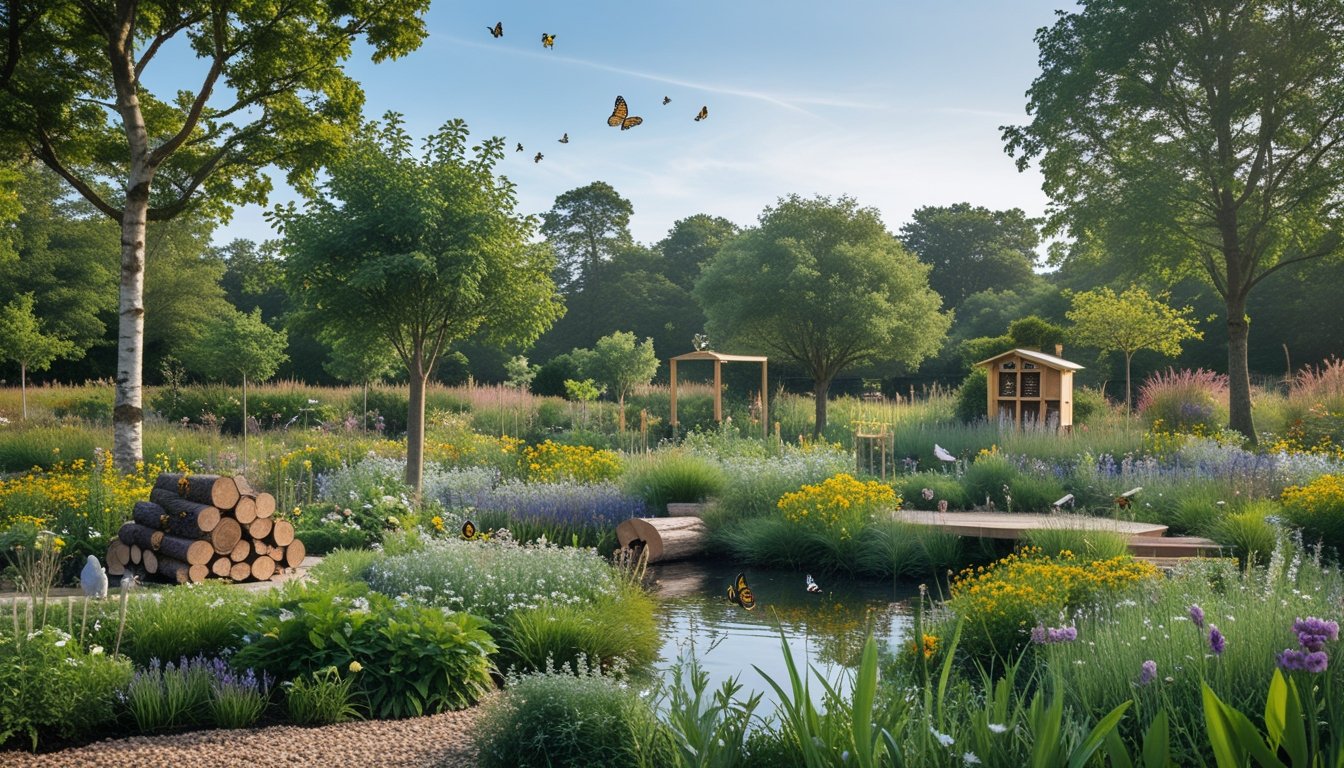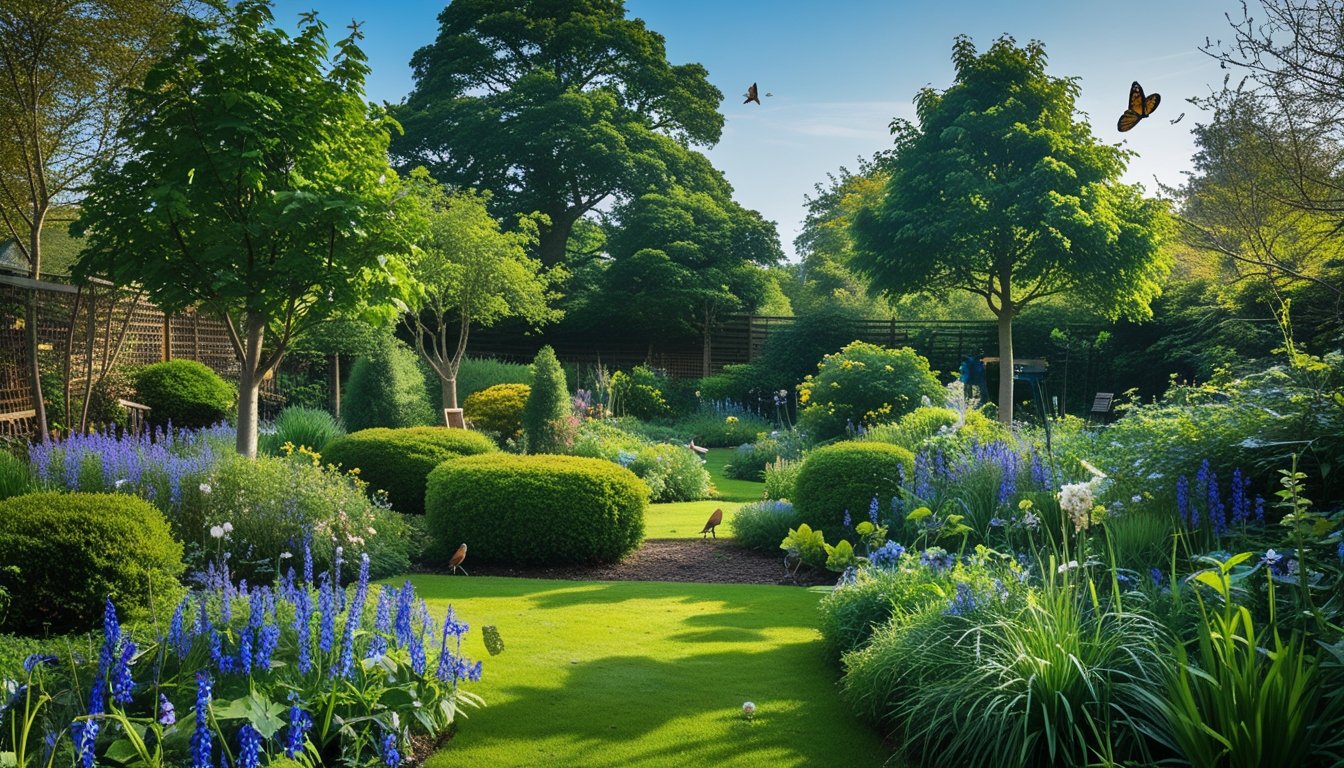Late updated: 03 Oct 2025 11:10
Written by: Emily Thornton
How To Create A Biodiverse UK Garden With Native Trees: A Comprehensive Guide
Creating a biodiverse garden in the UK with native trees is an enriching endeavour that not only enhances the natural beauty of our outdoor spaces but also supports the local ecosystem. By selecting native species, we provide essential food and habitat for a variety of wildlife. Incorporating native trees into our gardens is crucial as they are well-adapted to the local environment and play a significant role in supporting biodiversity.

Our gardens offer more than just aesthetic appeal; they serve as vital sanctuaries for wildlife. We can enhance these sanctuaries by introducing different plant layers and considering the needs of the species we aim to support. This approach nuances the ecosystem, making our gardens more resilient and sustainable. Moreover, understanding the conditions of our garden—such as soil type and sunlight exposure—will guide us in choosing the right native trees to plant.
Engaging in sustainable gardening practices will help create an environment where nature thrives. These efforts not only contribute positively to the environment but also transform our gardens into thriving habitats that attract birds, butterflies, and other pollinators. Embracing a practical and mindful approach to our gardening will significantly impact our local ecosystems.
Key Takeaways
- Native trees are essential for supporting local biodiversity.
- Layered plantings and sustainable practices enhance ecosystem resilience.
- Consider soil and sunlight to effectively integrate native trees.
Essential Steps To Create A Biodiverse UK Garden With Native Trees
Creating a biodiverse garden featuring native trees enhances local ecosystems. By choosing the right trees and plants, and supporting beneficial insects, we foster a thriving wildlife environment.
Selecting Appropriate Native Trees For UK Gardens
When selecting native trees for our UK garden, it's important to consider their ecological benefits and suitability to our specific garden conditions. Trees like rowan, hawthorn, and hazel are perfect choices. They provide shelter and food for various garden birds like wrens, as well as supporting insect life crucial for a healthy ecosystem.
The rowan tree, with its red berries, attracts many birds who feast on its fruits. Meanwhile, hawthorn offers nesting sites for birds and nectar for pollinators. Hazel, on the other hand, plays its part in supporting a variety of beneficial insects and provides nuts for wildlife.
Incorporating Native Wildflowers And Plants
Incorporating native wildflowers into our garden is fundamental for maintaining biodiversity. These plants, such as bluebells and cowslips, not only beautify our garden but also provide essential resources for bees, butterflies, and other pollinators. The diversity in flowers and their blooming periods ensures a constant supply of nectar and pollen throughout the seasons.
Creating a mosaic of plant types and colours invites a wider array of wildlife, enhancing biodiversity. Moreover, using companion planting techniques can also deter pests naturally, promoting a healthier environment for both plants and insects.
Layering Planting For Habitat Diversity
Layering involves planting trees, shrubs, and herbaceous plants at different heights to mimic a natural forest structure. This method provides diverse habitats and food sources. Taller trees like hawthorn serves as a canopy, while shrubs and groundcover plants like ferns fill the lower layers.
This stratified planting supports a broad spectrum of wildlife. For instance, butterflies lay eggs on various plant layers, while caterpillars feed, and mining bees burrow into the ground beneath. By mimicking natural environments, we support a multitude of species.
Supporting Pollinators And Beneficial Insects
To further sustain biodiversity, it’s crucial to attract pollinators and beneficial insects such as bees, butterflies, and hoverflies. Incorporating plants with different flowering periods ensures a continuous provision of nectar and pollen.
We can also create habitats by leaving piles of wood or creating insect hotels. These provide shelter and breeding grounds, especially for solitary bees. Supporting these insects not only aids in plant pollination but also in pest control, creating a more self-sustaining garden ecosystem. Through such methods, we contribute positively to our local environment, enhancing its biodiversity and resilience.
Habitat Features And Sustainable Practices For Wildlife Gardens

Creating a biodiverse wildlife garden involves enhancing natural habitats and practising sustainable gardening. By providing essential shelter, ensuring soil health, integrating necessary water features, and reducing chemical use, we can create a thriving environment for local wildlife.
Providing Shelter And Nesting Sites
Shelters and nesting sites are crucial for attracting and sustaining garden wildlife. Log piles and rockeries offer habitats for creatures like frogs and hedgehogs. Meanwhile, tall grass, nettles, and ivy provide cover for insects and small mammals.
Incorporating birdhouses helps support various bird species. A diverse range of nesting options enhances biodiversity. Simple features can turn a garden into a sanctuary. Ensuring each feature is maintained will keep it inviting for local species.
Improving Soil Health And Composting
Healthy soil is vital for a thriving garden ecosystem. Compost heaps are essential; they recycle organic waste and enrich the soil naturally. Incorporating compost and mulch improves soil structure and supports root development.
A balanced soil environment benefits plants and the creatures dependent on them. It’s important for us to monitor soil pH and nutrient levels. Leveraging natural composting techniques reduces the need for artificial fertilisers, making gardening more sustainable.
Integrating Water Features And Birdbaths
Water features like ponds and birdbaths not only enhance a garden’s aesthetic but also provide necessary hydration. These features attract birds, insects, and amphibians. Water areas should be accessible yet safe for small creatures.
A gentle slope or gradual sides can help prevent wildlife drowning. Regular cleaning and maintenance keep water features inviting. Adding aquatic plants can further support local species by offering food and shelter.
Minimising Herbicides And Encouraging Natural Predators
Reducing herbicide use benefits garden health and wildlife diversity. Instead of chemicals, we can encourage natural predators like ladybirds and common wasps. These creatures help control pest populations.
Biological control options are both effective and environmentally friendly. Encouraging a healthy predator population minimises the need for chemical interventions. It’s essential to monitor pest levels and establish a balanced ecosystem. By supporting these natural solutions, we contribute to a more sustainable approach to gardening.
Frequently Asked Questions

Choosing the right native UK trees and understanding their ecological roles can significantly enhance garden biodiversity. By addressing seasonal planting considerations and insect populations, we can create environments that sustain local wildlife effectively.
What are the best native UK tree species for promoting biodiversity in a garden?
Oaks, rowans, and silver birches are some of the top native UK trees that support biodiversity. Oaks, for instance, can sustain thousands of insect species. These trees not only provide shelter and food to wildlife but also integrate seamlessly into various garden ecosystems.
How can I ensure the survival of native tree saplings in my garden's ecosystem?
To increase the survival rate of saplings, it is crucial to plant them in suitable locations with appropriate soil conditions and access to sunlight. Regular watering during dry spells and protection from pests are vital. Mulching around the base can help retain moisture and regulate soil temperature.
In what ways do native trees support local wildlife and contribute to a balanced garden ecology?
Native trees offer habitat and food sources for numerous bird, insect, and mammal species. By nurturing these trees, we aid in the natural control of pests, such as caterpillars, through the ecosystem's own inhabitants like birds, thereby maintaining a balanced garden ecology.
What considerations should be made for seasonal changes when planting native UK trees in a garden?
Seasonal awareness is key. Plant deciduous trees in autumn or early spring when conditions are moist, reducing transplant shock. Understanding the growing patterns and dormancy periods of trees allows us to plan and plant effectively to meet each species' needs.
How does the introduction of native trees impact insect populations in a UK garden?
Incorporating native trees supports a wide range of insects by providing suitable habitats and nutrient sources. The presence of these insects boosts the garden's overall ecosystem health by supporting higher trophic levels like birds and small mammals, encouraging a healthy balance.
Can you suggest a planting strategy for native trees to maximise biodiversity in a small garden?
In small gardens, it is effective to plant trees that offer layered vegetation, such as coppiced hazel under larger oaks or rowans. This approach maximises vertical space and habitat variety, supporting diverse species. Ensuring a mix of tree ages can further enhance this effect.
